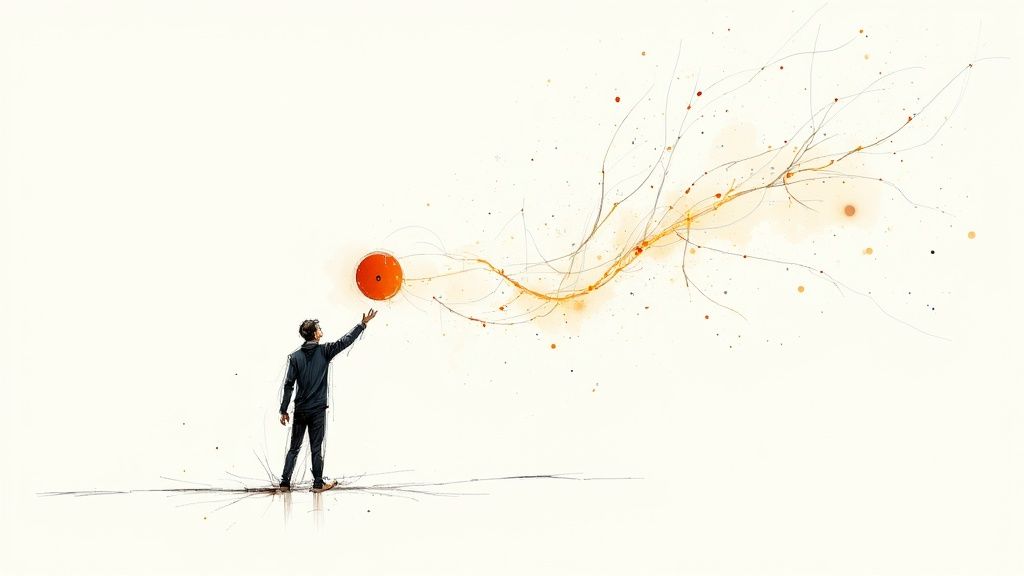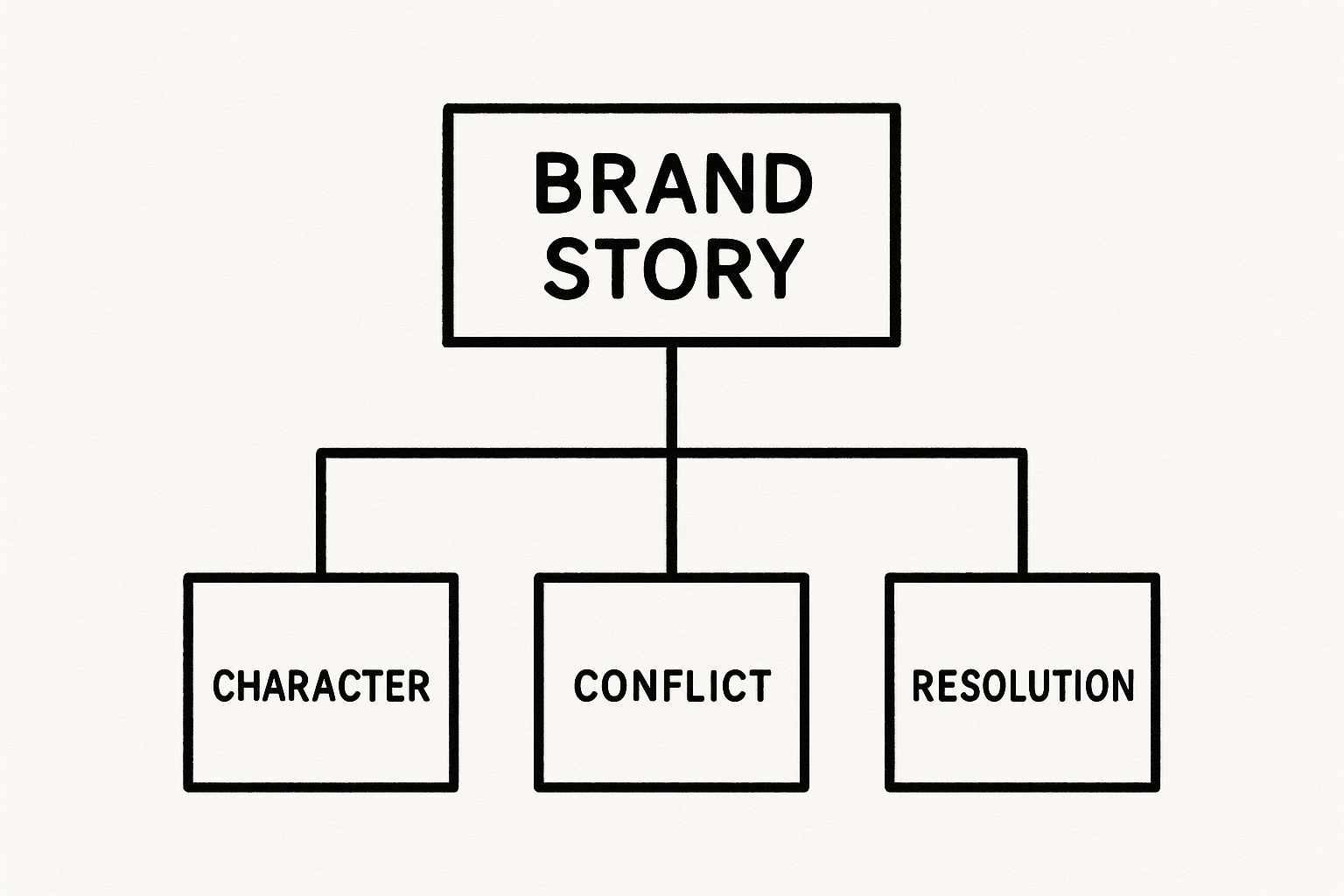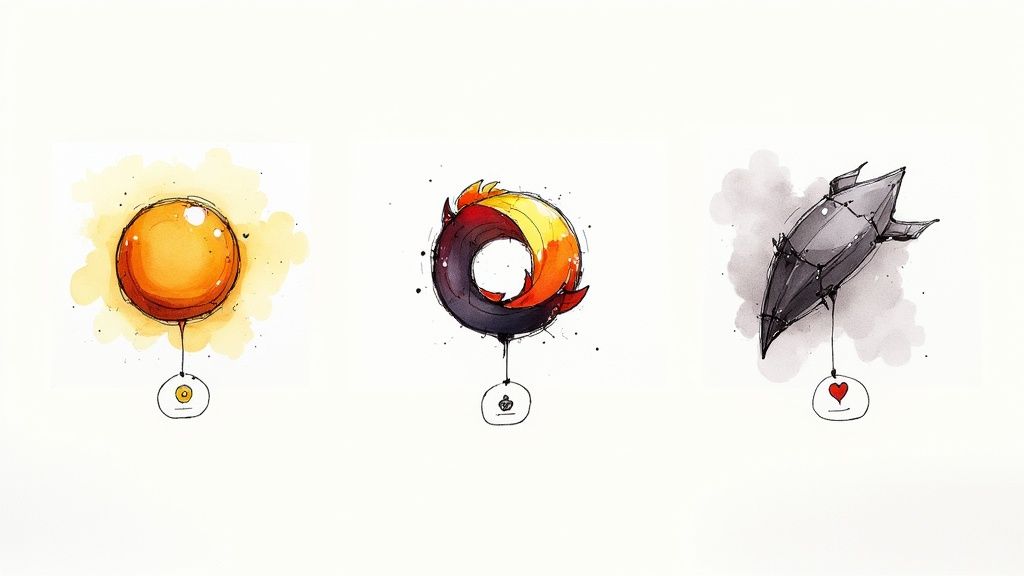What Is Brand Storytelling and How Does It Work?
Brand storytelling isn't a marketing buzzword—it's the art of using a narrative to forge a real connection with your customers. It's about shifting the focus from what you sell to why you sell it. This is how you communicate your values, your mission, and what you truly stand for.
Nail this, and you turn casual shoppers into die-hard fans.
Your Brand's Story Is Its Strongest Asset

Let's be blunt: a brand without a story is just a product. It has features, benefits, and a price tag. But a brand with a story? That's a movement. It has a personality, a purpose, and a reason to exist that goes far beyond the transaction.
Think of it this way: a product is a resume—a list of skills and qualifications. A brand story is a personality. It’s the passions, struggles, and unique worldview. Which one will you remember?
Moving from Transactional to Transformational
Facts are forgettable. Feelings build loyalty. For decades, marketing hammered us with the "what" (our product is faster!) or the "how" (it uses fancy new tech!). Brand storytelling cuts through the noise by focusing on the "why"—the core belief that gets you and your team out of bed in the morning.
This shift changes the game, taking your marketing from transactional to transformational. Instead of just selling, you’re:
Focusing on emotion over features: Connect with what your customers value, not just what's in their wallets.
Building relationships over sales: Create a community of people who believe what you believe.
Choosing authenticity over perfection: Share the real journey—highs, lows, and everything in between.
And this approach works. Brands that nail their storytelling see up to a 30% increase in conversion rates. What’s more, 15% of consumers will buy immediately if they connect with a brand’s story.
Here's a quick breakdown of how these two approaches stack up.
Brand Storytelling at a Glance
Element | Traditional Advertising | Brand Storytelling |
|---|---|---|
Focus | Product features & benefits | Brand values & purpose |
Goal | Drive immediate sales | Build long-term loyalty |
Communication | One-way broadcast (Telling) | Two-way dialogue (Showing) |
Tone | Persuasive & promotional | Authentic & relatable |
Customer Role | Passive consumer | Active participant/advocate |
Metric for Success | ROI, Conversion Rate | Engagement, Community Growth |
The difference isn't just tactical; it's a fundamental mindset shift from shouting at customers to inviting them into a conversation.
A strong brand narrative doesn’t just sell a product; it sells a belief. It gives customers a reason to choose you that competitors can't copy, turning your company into something people want to be a part of.
Ultimately, a story well told is the most powerful tool for elevating your brand from a commodity to something unforgettable. It’s the critical first step if you want to learn how to build brand awareness that actually lasts.
Why Human Brains Are Wired for Stories
Ever wonder why a good story gives you chills? It’s not just you. It’s neuroscience.
Our brains aren't built to remember feature lists. They're hardwired for narrative.
When you hear a story, your brain doesn't just process the words. It lights up the same areas that would be active if you were living the events yourself. This is neural coupling, and it’s the brain’s version of a direct download, letting the storyteller and listener sync up and share a common emotional experience.
But it’s not just a feeling; powerful chemistry is at play.
The Science of Connection and Trust
Listen to a story—especially one with a relatable character overcoming a challenge—and your brain gets a chemical kickstart. One of the most important neurochemicals released is oxytocin.
You might know it as the "trust hormone." It fuels empathy, generosity, and bonding.
When your brand tells a story that clicks, you're not just sharing information. You're building a biochemical foundation of trust. This is why stories about struggle and triumph work so well—they tap directly into our hardwired social bonding systems.
A well-told story literally changes our brain chemistry, making us more trusting and open. It’s the most powerful tool for turning a passive audience into an engaged community that believes in your mission.
Understanding these psychological triggers is a game-changer. For founders, the principles of behavioral marketing offer a roadmap for putting these insights into practice. It turns storytelling from a fluffy art form into a repeatable, science-backed strategy.
Making Memories That Stick
How much better are stories than cold, hard facts? Research shows information wrapped in a story can be up to 22 times more memorable.
Why the huge gap?
It’s how our brains file information. Facts are processed in a small language-processing part of the brain. Stories fire up the whole system:
The sensory cortex lights up with rich, descriptive details.
The motor cortex gets in on the action when the story describes movement.
The frontal cortex processes the emotional core of the narrative.
This full-brain workout creates a much richer, stickier memory that’s far easier to recall.
By wrapping your brand’s message in a narrative, you aren't just hoping people remember you—you're using neuroscience to make sure they do. Brand storytelling isn't just a trend; it's a direct line to the human operating system.
The Core Elements of a Powerful Brand Story
A magnetic brand story doesn't just happen. It's built on a timeless framework that taps into human psychology. Every great story, from ancient myths to Hollywood blockbusters, shares the same DNA.
Understanding these components gives you a practical toolkit. Stop thinking in abstract terms and start building a real narrative that grabs your audience and doesn't let go. These are the non-negotiable ingredients.
The infographic below boils this powerful structure down into three simple pillars.

This visual guide cuts through the noise. Every story worth telling is a journey from conflict to resolution, and it all revolves around one central character.
Your Customer Is the Hero
Here’s the biggest mistake in brand storytelling: casting your brand as the hero. Get this straight: your customer is the hero, always. They're on a quest, facing real challenges and dreaming of a better future. Your story has to be told through their eyes.
To define your hero, ask:
What does my ideal customer really want?
What are their deepest values and beliefs?
What does a “win” actually look like for them?
When you position your customer as the main character, they instantly see themselves in the narrative. It’s a simple shift that changes everything.
The Conflict Is Their Problem
No conflict, no story. Period. The conflict is the roadblock standing between your hero and what they want. It’s the nagging problem, the deep frustration, or the unmet need that forces them to act. A clear conflict builds tension and makes the ending feel earned.
A story without a clear conflict is just a statement. The struggle creates emotional investment and makes an audience care about the outcome.
This is where your brand’s reason for being comes into sharp focus. Your product wasn't created in a vacuum; it exists to solve this specific problem. Nailing this is fundamental when figuring out what is product positioning and how to claim a unique spot in your customer's mind.
Your Brand Is the Mentor
While the customer gets the starring role, your brand plays a critical supporting part: the mentor or guide. Like a wise character in a film, your brand steps in to give the hero the plan, tools, or insight they need to overcome the conflict.
Your job is to empower the hero, not save them. This is your chance to introduce what makes you special—not as a sales pitch, but as the essential tool for their journey.
And of course, every great story needs a satisfying ending.
The Resolution Is Their Transformation
The end of the story isn't about your product’s features; it’s about the hero's transformation. How is their life genuinely better now that their problem is solved? This is the "happily ever after" moment.
It answers the question: What does success look like for your customer?
Before: They were struggling with [the conflict].
After: They feel empowered, confident, or relieved because they achieved [the resolution].
This transformation is the emotional payoff that makes your brand story unforgettable. Focus on these core elements to build a narrative that turns passive listeners into passionate believers.
How Winning Brands Tell Their Stories

Theory is one thing. Action is another. The best brands don't just tell a story once; they live and breathe it across every touchpoint. From a tweet to their packaging, their narrative is the golden thread that creates a cohesive, memorable experience.
Let's dissect how the greats pull it off, using the core elements: Hero, Conflict, Mentor, and Resolution. These aren't just marketing campaigns; they are strategic narratives that build devoted followings.
Case Study: Dove The Mentor for Real Beauty
Dove’s story is a masterclass in turning a product into a movement. For decades, the beauty industry set an impossible standard that left most people feeling inadequate. Dove saw this universal struggle and built their identity around challenging it.
The Hero: Everyday women who feel alienated by unrealistic beauty standards.
The Conflict: The constant battle with self-esteem, fueled by a narrow, unattainable definition of beauty.
The Mentor (Dove): Dove steps in, not with a magic fix, but with the tools and platform to challenge those norms and celebrate "real beauty."
The Resolution: Women feel empowered, seen, and confident in their own skin, defining beauty on their own terms.
This narrative isn't just on their "About Us" page. It’s the entire point of their "Real Beauty" campaigns, their social feed, and their product messaging. They consistently act as the guide helping their audience find confidence.
Case Study: Airbnb Belonging Anywhere
Airbnb flipped the hospitality industry on its head—not by talking about rooms, but by telling a story about human connection. They knew travelers weren't just looking for a place to crash; they were searching for genuine experiences and a sense of belonging.
A brand story is powerful when it sells a feeling, not a feature. Airbnb sells belonging, not bookings. It’s a subtle but critical distinction that transforms a transaction into a relationship.
Their story isn't even told by them—it's told through their users. The hosts and guests are the main characters, and their personal journeys reinforce the brand's core message. Every host profile and guest review adds another chapter to a global narrative of community and connection.
Case Study: Nantucket Nectars The Underdog Dream
Nantucket Nectars built its brand on the classic underdog story we all love. They literally printed their journey of starting with "a blender and a dream" on every bottle. This wasn't just a quirky detail; it was a deliberate narrative choice that made the brand instantly relatable and authentic.
The Hero: The two founders, Tom and Tom, representing anyone with a big dream and not much else.
The Conflict: The impossible challenge of taking on massive beverage corporations with nothing but passion.
The Resolution: They succeed against all odds, proving that a genuine product and a great story can win.
This narrative makes you want to see them succeed. Buying their juice becomes a small vote for the little guy. They brilliantly turned their founding story into their strongest marketing asset.
These examples prove that a powerful brand story is consistent, customer-centric, and authentic. It's a living narrative that evolves but always stays true to its core "why." That consistency is crucial, especially on social media, where 88% of Gen Z consumers say a brand’s social media presence heavily influences their trust. You can learn more about how branding statistics shape consumer trust and see why getting this right matters.
A Step-by-Step Guide to Crafting Your Brand Narrative

Alright, enough theory. Let’s get our hands dirty.
Crafting a brand story isn’t about writing fiction. It’s an excavation project. Your job is to uncover the authentic, powerful narrative that already exists inside your business and give it a voice.
This guide gives you five actionable steps. Follow them, and you’ll walk away with a solid foundation for a story that connects.
Step 1: Uncover Your Foundational Why
Before you tell your story, know why you're telling it. Your "why" is the reason your company exists beyond making money. It's the mission that fuels the late nights. This is the heart of your narrative.
To find it, ask some tough questions:
What problem were we created to solve?
If we vanished tomorrow, what would our customers genuinely miss?
What’s the one core belief that drives every decision we make?
Your answers are the bedrock of an authentic story. Don’t rush this. Your "why" is the emotional core that makes people care.
Step 2: Define Your Customer's True Story
Remember: your customer is the hero, not you. To tell their story well, you have to understand them deeper than just demographics. Step into their world.
Think about their daily life. What are their biggest fears, frustrations, and hopes? What does a "win" really look like for them, both personally and professionally?
Once you understand their internal and external struggles, you can position your brand as the guide they've been searching for.
Your story isn't about your company's journey; it's about how your company empowers your customer on their journey. This shift in perspective is everything.
Step 3: Identify the Core Conflict
Every great story needs a villain. In brand storytelling, the villain is the problem your brand exists to destroy. This is the central conflict—the obstacle standing between your customer (the hero) and the transformation they crave.
A clear conflict creates tension and makes your solution feel essential. Is the enemy a lack of time? A frustratingly complex process? The feeling of being overlooked? Define this villain with precision. A specific problem demands a specific solution, making your brand’s role crystal clear.
Step 4: Weave Your Narrative with a Consistent Voice
With the core elements in place, start writing. Your tone and voice are your story's personality. Are you the witty expert, the compassionate friend, or the rebellious innovator? Whatever you choose, that voice must show up consistently everywhere.
A consistent voice builds trust and makes your brand instantly recognizable. If you need a roadmap, exploring a comprehensive brand storytelling framework can give you the structure you need.
Step 5: Map Your Story Across Every Channel
Finally, a story is useless if no one hears it. Map out how your narrative will live across all your channels—from your "About Us" page to social media and email newsletters. Think of each channel as a different stage for telling the same core story.
This skill is only getting more critical. Data storytelling is projected to become the primary way people consume complex information by 2025. This shows how much audiences expect brands to combine hard data with a compelling narrative. Strategic distribution ensures your message isn't just heard, but felt.
Got Questions About Brand Storytelling?
Even with a clear plan, questions pop up. Here are the most common ones founders ask. Use this as your quick-reference guide to clear any hurdles and start telling your story with confidence.
How Is Brand Storytelling Different from Content Marketing?
Good question. It's a common point of confusion.
Think of it this way: content marketing is the vehicle; brand storytelling is the soul of the driver. Content marketing is the actual stuff you create—blog posts, videos, social updates. It's the "what."
Brand storytelling is the bigger picture. It's the core narrative that ties all that content together, giving it a consistent purpose. Your story dictates what content you create and why.
A random blog post is just content. A blog post that reinforces your mission by showing how a customer's life changed? That's brand storytelling in action.
Brand storytelling isn't a type of content; it's the soul inside all of your content. It ensures every single thing you publish, from a tweet to a case study, feels like it comes from the same authentic place.
For a deeper look, this article on What Is Brand Storytelling breaks down its role in building lasting loyalty.
Can a Small Business Really Use Brand Storytelling?
Absolutely. In fact, it's a startup's secret weapon.
Big corporations have massive ad budgets. You have authenticity. You have a direct line to your "why."
Your founding story—the problem that kept you up at night, the garage-office days, the thrill of your first customer—is pure gold. It's a powerful narrative a faceless corporation can't replicate. Storytelling doesn't require a Hollywood budget; it just requires being real.
Share your story right now through:
A simple, heartfelt "About Us" page.
A personal note from the founder in your next newsletter.
Behind-the-scenes videos or photos on social media.
Your story is your biggest differentiator. Don't hide it.
What Are the Biggest Mistakes to Avoid?
Three big ones come to mind.
First, making the brand the hero. Wrong. Your customer is always the hero. Your brand is the wise guide who gives them the tool or insight they need to win. Focus on their journey, not your product's features.
The second mistake is inconsistency. Your story must be the same everywhere—on your website, in ads, during sales calls, and in customer support. A disjointed narrative shatters trust before it can form.
Finally, don't fake it. Consumers can spot an inauthentic story from a mile away, and it’s the fastest way to lose credibility. Your best story is your true story, told in a compelling way. Don't invent a purpose; uncover the one you already have.










